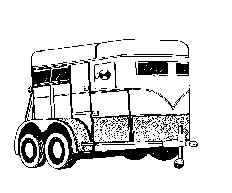

To send a message to an author, click on the author's name at the end of the article.
This Month in Ag Connection | Ag Connection - Other Issues Online

Beginning in 2001 long-term capital gains (LTCG) that would otherwise be taxed at 10% (maximum rate for LTCG in the 15% regular income tax bracket) will be taxed at a maximum rate of 8% if the asset(s) have been held for more than five (5) years. For 2000 if your tax status is "married filing jointly" the taxable income jump from the 15% to 28% regular income tax bracket is at $43,850; for singles the bracket jump is at $26,250.
The corresponding reduction of the maximum tax rate on LTCG of 20% to 18% will not be available for taxpayers to utilize until 2006 - because the holding period for assets to qualify under this provision must begin after 2000.
Relative to the reduction from 20% to 18% in 2006, there is a provision that allows taxpayers to recognize to-date gains on pre-held 2001 assets -- pay the tax on accumulated gain and get a new holding period start date in 2001. While this might be an advantage in a few situations, proceed with caution in electing to pay taxes at least 5 years in advance for a 10% (2% divided by 20%) potential tax savings. A situation where it might be appropriate to make this election is where little gain has been realized up to 2001 but very significant gains are anticipated over the next 5 years.
(Author:Parman R. Green, Farm Business Mgmt. Specialist)
This Month in Ag Connection | Ag Connection - Other Issues Online
If you are interested in participating in the Show Me Select Heifer Development program, you need to indicate that interest to your local Livestock Specialist by February 1, 2001. Enrolling does not obligate you to sell, but does indicate your interest. For more information, contact your local Livestock Specialist or click here to view web site.
(Author: Mark Stewart, Livestock Specialist)
This Month in Ag Connection | Ag Connection - Other Issues Online
Research has shown that horses facing backwards are less stressed and can balance themselves better than with forward travel but, individual horses may have different preferences. A roomy trailer allows each horse to choose their most comfortable travel position, thus warding off stiffness from long trips. Ventilation is an important aspect of horse trailer design. Air movement through the trailer should be sufficient to provide clean fresh air without creating stress on the horse. Leaving horses untied or on a long tie allows for additional freedom of movement, so the horse can avoid breathing exhaust fumes, and dust from bedding, hay, and the road.
Trailers should have matched tires in good condition that are of the proper size and inflation. The suspension should comfortably soak up irregular road conditions. The best trailer in excellent condition will not make up for poor driving habits during hauling. So think about the horse's comfort while you are behind the steering wheel.
A trip of 10 to 12 hours requires a 6 to 8 hour rest before using the horse. Half-hour breaks every 4 hours of travel are not enough. Research has shown that frequent short breaks during a long trip do not allow horses to recover from the stress of a long trip. Long trips also increase the chances for infections. The immune system becomes depressed during the travel and horses need sufficient time to rebound. The longer the trip the greater affect on the immune system. Be aware the health status of your horse(s) before a trip. Finally, horses should rest at least a week after returning home from a long trip.
Information for this article was supplied by Erika L. Berg, Graduate Research Assistant in the Animal Science Department at the University of Missouri, from Equus 270, Equine Veterinary Science, and the American Horse Show Association and Massachusetts Society for Prevention of Cruelty to Animals guidelines.
(Author: Jim Jarman, Agronomy Specialist)
This Month in Ag Connection | Ag Connection - Other Issues Online
*From Equus 270
This Month in Ag Connection | Ag Connection - Other Issues Online

In the feeder cattle market, both shrink and weighing conditions impact pricing. Two types of shrink should be considered – pencil shrink and transit shrink. Pencil shrink is a percentage of gross weight that is deducted to determine sale weight, as seen in Table A.
Scale Weight = 600 lbs
Pencil Shrink = 3%
Sale Price = $1.00/lbs
600 lbs. * 97% = 582 lbs. Sale Weight
582 lbs. * $1 = $582.00 Cattle Cost
Cattle purchased through auction markets are generally weighed after they are purchased to determine sale weight with no pencil shrink applied to the scale weight. The degree of fill on the cattle (how much feed and water they consumed just prior to sale) can impact purchase cost and feedyard performance.
For example, if a 500-pound steer sold for $1.00 per pound, it would cost $500. If the same steer were restricted from feed and water until just prior to the sale and then consumed enough feed and water to regain normal fill plus 25 pounds more, it would cost an additional $25, which would equate to $1.05 per pound for the 500 pounds of true weight.
Experienced order buyers generally are able to detect such variables and adjust bid prices accordingly. Excess fill is not true weight gain; therefore, more time in the feedyard is required to reach slaughter weight. This means more days on feed, a less desirable feed/gain ratio and a higher cost of gain.
When cattle are purchased at the farm by order buyers, commission agents, or private treaty, the buyer and seller should agree on weigh conditions and pencil shrink. This will include how, when and where the cattle are weighed. For example, in some cases cattle are weighed immediately off pasture. Others may gather them the night before shipment, allow them to stand overnight without access to feed and weigh them the next morning. See Table B.
| Scale Weight, Lbs. | Payweight | Adjusted Bid per lb. | |
|---|---|---|---|
| a.m. gather, no pencil shrink | 500 | 500 | $1.00 |
| a.m. gather, 3% pencil shrink | 500 | 485 | $1.03 |
| 4% transit shrink*, no pencil shrink | 480 | 480 | $1.04 |
| 4% transit shrink*, 2.5% pencil shrink | 480 | 468 | $1.07 |
| 5% stand shrink, no pencil shrink | 475 | 475 | $1.05 |
If scales are available locally, the cattle will weigh more because they will lose less fill in the weighing process. The distance cattle are hauled to be weighed is related to the degree of shrink (transit shrink). Most shrink occurs during loading, the first part of the haul, and unloading. Shrinkage increases at a slower rate with additional miles.
If cattle are weighed on the truck, calculated weight will depend on when the trucks themselves are weighed. If trucks are weighed prior to picking up cattle, the calculated cattle weight will be greater than if the truck is weighed after delivery because manure and urine will accumulate in the truck during transit.
Regardless of weigh conditions and pencil shrink, the actual price paid must reflect true market value for the animals to be a good buy. Shown in Table B are examples of adjusted bid prices to equate the true value per pound based on different weigh conditions of the same steer. If a steer weighs 500 pounds and the market value is $1.00 per pound, the total cost would be $500.
The amount of shrink will vary with each group of cattle. Cattle on lush pasture or high moisture forage will shrink more than those on dry grass or a concentrate ration. Freshly weaned calves will shrink more than those that have already gone through the stress of weaning.
Cattle that have had very little close contact with humans will generally be more excitable and nervous. Consequently, they will shrink more than tamer cattle.
While much of the shrink will be recouped when feed and water are made available, cattle can require two to three weeks to regain their payweight at the feedyard. In long-hauled cattle, up to 50 percent of the weight loss is tissue shrink which is regained more slowly than fill losses. The degree to which shrink affects an animal’s performance depends on shrink relative to total gain.
(Author: John W. McNeill, PhD, Extension Beef Cattle Specialist, Texas Agriculture Extension Service - Amarillo)
This Month in Ag Connection | Ag Connection - Other Issues Online
As one year winds down, it's time to start thinking about the next cropping season. Many have already done tillage and applied fertilizer for next year's crop. Early purchase deals for seed, chemicals and other inputs encourage making decisions on what you will plant in 2001. How and when you might market that crop should be a part of these production decisions.
Avoid harvest time sales. For the last two years corn and soybean prices have tended to bottom out at or just before harvest. Avoiding sales during harvest and storing has offered returns both years--if you didn't store too long. Will large supplies, a weak harvest time basis and low prices again be the situation in 2001? If so, storing to avoid price lows and to capture basis improvement along with post-harvest price gains may again be a profitable alternative. For grain that you can't store, avoiding harvest time price lows requires looking for and taking advantage of sales opportunities early in the season.
Pre-harvest sales should be made before July 4th. Seasonal price patterns offer good guides for beginning to make early marketing plans. Prices tend to rally from fall lows into spring. Late spring and early summer rallies often occur, in part, due to planting or production concerns. Once it begins to "look like the crop is made," usually about July 4, prices tend to decline (often sharply) to their fall lows. If you wait past early July to make sales, because you want to see what your crop prospects are, you've probably waited too long! Using crop insurance to manage yield risk and spreading sales out on spring rallies is usually a better strategy. It may not get the market high, but it puts the odds for above average prices in your favor.
What if I'm wrong? That idea often stands in the way of good marketing decisions, especially early in the marketing year. What if you do make sales and then prices go much higher--no one ever wants to miss out on high prices! This is always a real possibility. World grain use is at or near record levels and any production hiccup anywhere could quickly impact prices. While this is a valid concern, there are ways to manage this risk. Making early sales with minimum price contracts or using put options are possible sales strategies that leave the "top side" open. Another strategy might be to purchase call options to offset forward cash contracts or futures hedges. Using these or other combinations of marketing tools can manage the risk of being "wrong" and still allow you to capture early sales opportunities.
Plans need to be flexible and recognize how the production or price situation could change. Also keep in mind how the LDP or market loan fits in with your strategies to deal with low prices. It's early, but not too early to start making plans for 2001 marketing.
(Author: Melvin Brees, Farm Management Specialist)
This Month in Ag Connection | Ag Connection - Other Issues Online
Publishing Information
Ag Connection is published monthly for Northeast and Central areas of Missouri producers and is supported by the University of Missouri Extension, the Missouri Agricultural Experiment Station, and the MU College of Agriculture, Food and Natural Resources. Managing Editor: Mary Sobba.